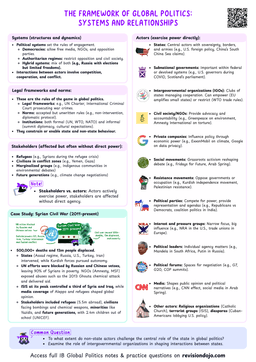Understanding Interdependence
Interdependence
Interdependence refers to the mutual reliance between actors in the international system, such as states, organizations, and individuals.

- Economic Interdependence:
- Trade: Countries rely on each other for goods and services.
- Investment: Cross-border investments create financial linkages.
- Example: The global supply chain for electronics involves components from multiple countries.
- Political Interdependence:
- Diplomacy: States collaborate on issues like climate change and security.
- Institutions: Organizations like the UN facilitate cooperation.
- Example: The Paris Climate Agreement requires collective action to address global warming.
- Social and Cultural Interdependence:
- Migration: People move across borders, sharing cultures and ideas.
- Communication: Technology connects individuals worldwide.
- Example: Social media platforms enable global movements like #MeToo.
- Interdependence is not always symmetrical.
- Some actors may have more power or influence, leading to imbalances in relationships.
Theoretical Perspectives on Interdependence
- Liberalism:
- Emphasizes the benefits of cooperation and institutions.
- Argues that interdependence reduces the likelihood of conflict.
- Realism:
- Views interdependence with skepticism, highlighting vulnerabilities.
- Argues that states prioritize security and may exploit dependencies.
- Constructivism:


